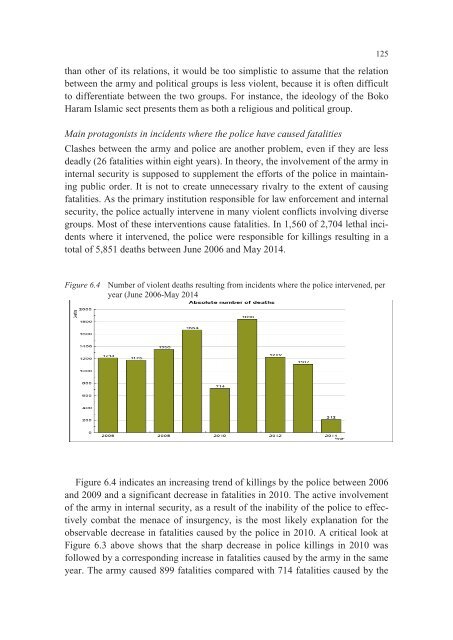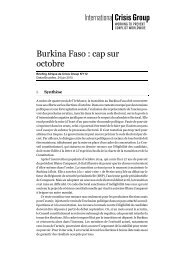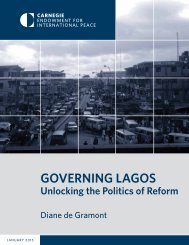Violence in Nigeria
ASC-075287668-3743-01
ASC-075287668-3743-01
You also want an ePaper? Increase the reach of your titles
YUMPU automatically turns print PDFs into web optimized ePapers that Google loves.
than other of its relations, it would be too simplistic to assume that the relation<br />
between the army and political groups is less violent, because it is often difficult<br />
to differentiate between the two groups. For <strong>in</strong>stance, the ideology of the Boko<br />
Haram Islamic sect presents them as both a religious and political group.<br />
Ma<strong>in</strong> protagonists <strong>in</strong> <strong>in</strong>cidents where the police have caused fatalities<br />
Clashes between the army and police are another problem, even if they are less<br />
deadly (26 fatalities with<strong>in</strong> eight years). In theory, the <strong>in</strong>volvement of the army <strong>in</strong><br />
<strong>in</strong>ternal security is supposed to supplement the efforts of the police <strong>in</strong> ma<strong>in</strong>ta<strong>in</strong><strong>in</strong>g<br />
public order. It is not to create unnecessary rivalry to the extent of caus<strong>in</strong>g<br />
fatalities. As the primary <strong>in</strong>stitution responsible for law enforcement and <strong>in</strong>ternal<br />
security, the police actually <strong>in</strong>tervene <strong>in</strong> many violent conflicts <strong>in</strong>volv<strong>in</strong>g diverse<br />
groups. Most of these <strong>in</strong>terventions cause fatalities. In 1,560 of 2,704 lethal <strong>in</strong>cidents<br />
where it <strong>in</strong>tervened, the police were responsible for kill<strong>in</strong>gs result<strong>in</strong>g <strong>in</strong> a<br />
total of 5,851 deaths between June 2006 and May 2014.<br />
125<br />
Figure 6.4 Number of violent deaths result<strong>in</strong>g from <strong>in</strong>cidents where the police <strong>in</strong>tervened, per<br />
year (June 2006-May 2014<br />
Figure 6.4 <strong>in</strong>dicates an <strong>in</strong>creas<strong>in</strong>g trend of kill<strong>in</strong>gs by the police between 2006<br />
and 2009 and a significant decrease <strong>in</strong> fatalities <strong>in</strong> 2010. The active <strong>in</strong>volvement<br />
of the army <strong>in</strong> <strong>in</strong>ternal security, as a result of the <strong>in</strong>ability of the police to effectively<br />
combat the menace of <strong>in</strong>surgency, is the most likely explanation for the<br />
observable decrease <strong>in</strong> fatalities caused by the police <strong>in</strong> 2010. A critical look at<br />
Figure 6.3 above shows that the sharp decrease <strong>in</strong> police kill<strong>in</strong>gs <strong>in</strong> 2010 was<br />
followed by a correspond<strong>in</strong>g <strong>in</strong>crease <strong>in</strong> fatalities caused by the army <strong>in</strong> the same<br />
year. The army caused 899 fatalities compared with 714 fatalities caused by the






